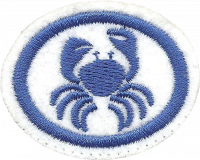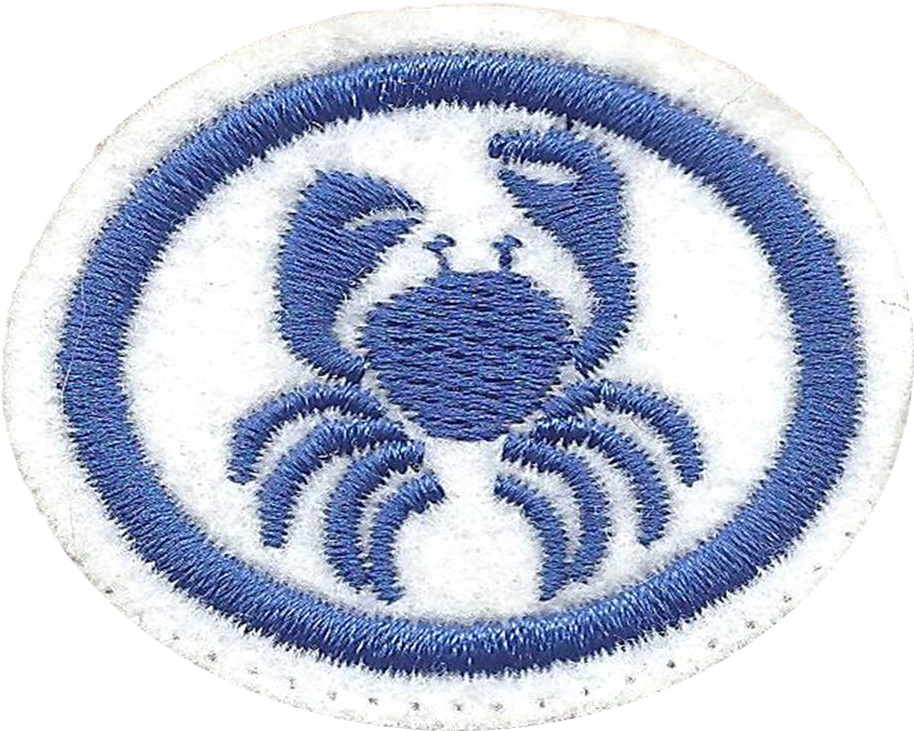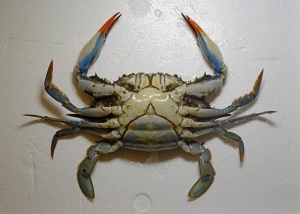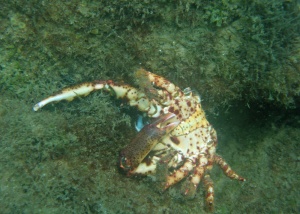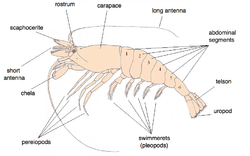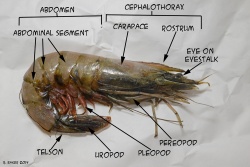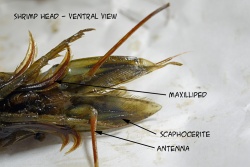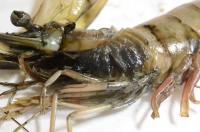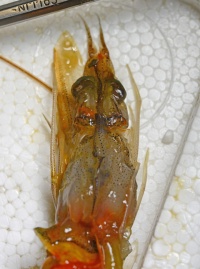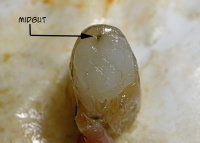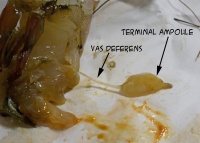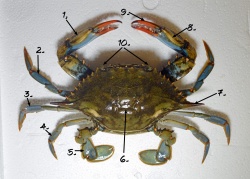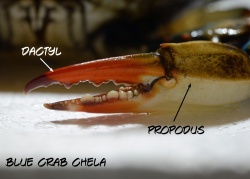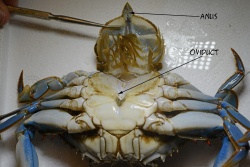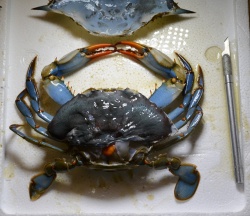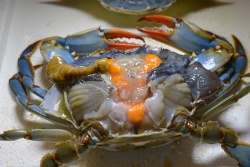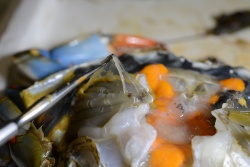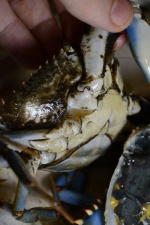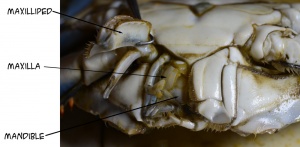Difference between revisions of "AY Honors/Crustaceans/Answer Key/es"
From Pathfinder Wiki
< AY Honors | CrustaceansAY Honors/Crustaceans/Answer Key/es
(Created page with "{{clear}}") |
|||
| (29 intermediate revisions by 2 users not shown) | |||
| Line 76: | Line 76: | ||
{{CloseReq}} <!-- 7 --> | {{CloseReq}} <!-- 7 --> | ||
{{ansreq|page={{#titleparts:{{PAGENAME}}|2|1}}|num=8}} | {{ansreq|page={{#titleparts:{{PAGENAME}}|2|1}}|num=8}} | ||
| − | <noinclude> | + | <noinclude></noinclude> |
| − | </noinclude> | + | <!-- 8. ¿Cómo se puede diferenciar entre un sirí macho y una hembra? ¿Por qué es importante? --> |
| − | <!-- 8. | ||
| − | |||
| − | + | {{clear}} | |
| − | |||
| − | |||
| − | |||
[[Image:BlueCrab 0553 W.jpg|300px]] | [[Image:BlueCrab 0553 W.jpg|300px]] | ||
[[Image:Crab 3396 W.jpg|300px]] | [[Image:Crab 3396 W.jpg|300px]] | ||
| − | |||
<noinclude></noinclude> | <noinclude></noinclude> | ||
{{CloseReq}} <!-- 8 --> | {{CloseReq}} <!-- 8 --> | ||
{{ansreq|page={{#titleparts:{{PAGENAME}}|2|1}}|num=9}} | {{ansreq|page={{#titleparts:{{PAGENAME}}|2|1}}|num=9}} | ||
| − | <noinclude> | + | <noinclude></noinclude> |
| − | </noinclude> | + | <!-- 9. ¿Cuál es la importancia de lo micro crustáceos para el medio ambiente? --> |
| − | <!-- 9. | ||
| − | |||
{{clear}} | {{clear}} | ||
| − | + | {{clear}} | |
| − | |||
| − | |||
<noinclude></noinclude> | <noinclude></noinclude> | ||
{{CloseReq}} <!-- 9 --> | {{CloseReq}} <!-- 9 --> | ||
{{ansreq|page={{#titleparts:{{PAGENAME}}|2|1}}|num=10}} | {{ansreq|page={{#titleparts:{{PAGENAME}}|2|1}}|num=10}} | ||
| − | <noinclude> | + | <noinclude></noinclude> |
| − | </noinclude> | + | <!-- 10. Realizar las siguientes actividades y presentar un informe ilustrado: --> |
| − | <!-- 10. | ||
| − | |||
<noinclude></noinclude> | <noinclude></noinclude> | ||
| Line 116: | Line 104: | ||
<noinclude></noinclude> | <noinclude></noinclude> | ||
| − | + | {{clear}} | |
| − | |||
| − | |||
| − | |||
[[Image:Crangon_crangon.png|250px]] | [[Image:Crangon_crangon.png|250px]] | ||
[[Image:ShrimpAnatomy 0480 edited-W.jpg|250px]] | [[Image:ShrimpAnatomy 0480 edited-W.jpg|250px]] | ||
[[Image:ShrimpHead 0502 W.jpg|250px]] | [[Image:ShrimpHead 0502 W.jpg|250px]] | ||
| − | |||
| − | + | {{clear}} | |
| − | |||
| − | |||
| − | |||
[[Image:Shrimp 0491.jpg|200px]] | [[Image:Shrimp 0491.jpg|200px]] | ||
[[Image:Shrimp 0645.jpg|200px]] | [[Image:Shrimp 0645.jpg|200px]] | ||
[[Image:ShrimpMidgut 0505 W.jpg|200px]] | [[Image:ShrimpMidgut 0505 W.jpg|200px]] | ||
[[Image:ShrimpReproductive 0507 P.jpg|200px]] | [[Image:ShrimpReproductive 0507 P.jpg|200px]] | ||
| − | |||
| − | + | {{clear}} | |
| − | |||
| − | |||
| − | |||
[[Image:BlueCrab 0540 W.jpg|250px]] | [[Image:BlueCrab 0540 W.jpg|250px]] | ||
[[Image:BlueCrab 0547 W.jpg|250px]] | [[Image:BlueCrab 0547 W.jpg|250px]] | ||
[[Image:BlueCrab 0609.jpg|250px]] | [[Image:BlueCrab 0609.jpg|250px]] | ||
| − | |||
| − | + | {{clear}} | |
| − | + | [[Image:BlueCrab 0618.jpg|250px]] | |
| + | [[Image:BlueCrab 0619.jpg|250px]] | ||
| + | [[Image:BlueCrab 0647.jpg|250px]] | ||
{{clear}} | {{clear}} | ||
| − | + | [[Image:BlueCrab 0655.jpg|150px]] | |
| + | [[Image:CrabMouth 0664 W.jpg|300px]] | ||
| − | + | <noinclude></noinclude> | |
| − | <noinclude | ||
| − | |||
{{CloseReq}} <!-- 10a --> | {{CloseReq}} <!-- 10a --> | ||
{{ansreq|page={{#titleparts:{{PAGENAME}}|2|1}}|num=10b}} <!--T:11--> | {{ansreq|page={{#titleparts:{{PAGENAME}}|2|1}}|num=10b}} <!--T:11--> | ||
| − | <noinclude> | + | <noinclude></noinclude> |
| − | </noinclude | ||
| − | |||
| − | + | {{clear}} | |
| − | |||
| − | |||
| − | + | <noinclude></noinclude> | |
| − | <noinclude | ||
| − | |||
{{CloseReq}} <!-- 10b --> | {{CloseReq}} <!-- 10b --> | ||
| + | |||
| + | {{ansreq|page={{#titleparts:{{PAGENAME}}|2|1}}|num=10c}} | ||
| + | <noinclude></noinclude> | ||
| + | <noinclude></noinclude> | ||
| + | {{CloseReq}} <!-- 10c --> | ||
{{CloseReq}} <!-- 10 --> | {{CloseReq}} <!-- 10 --> | ||
{{ansreq|page={{#titleparts:{{PAGENAME}}|2|1}}|num=11}} | {{ansreq|page={{#titleparts:{{PAGENAME}}|2|1}}|num=11}} | ||
| − | <noinclude> | + | <noinclude></noinclude> |
| − | </noinclude> | + | <!-- 11. Ser capaz de identificar en vivo o a través de imágenes de los siguientes animales: --> |
| − | <!-- 11. | ||
| − | |||
| − | + | <noinclude></noinclude> | |
| − | <noinclude | ||
| − | |||
{{ansreq|page={{#titleparts:{{PAGENAME}}|2|1}}|num=11a}} <!--T:13--> | {{ansreq|page={{#titleparts:{{PAGENAME}}|2|1}}|num=11a}} <!--T:13--> | ||
| − | <noinclude> | + | <noinclude></noinclude> |
| − | </noinclude> | ||
<gallery mode="traditional"> | <gallery mode="traditional"> | ||
| − | File:Barnacle 6758 W.jpg| | + | File:Barnacle 6758 W.jpg|Balanos |
| − | File:Barnacle 6843 W.jpg| | + | File:Barnacle 6843 W.jpg|Balanos comiendo |
</gallery> | </gallery> | ||
| − | |||
| − | + | <noinclude></noinclude> | |
| − | <noinclude | ||
| − | |||
{{CloseReq}} <!-- 11a --> | {{CloseReq}} <!-- 11a --> | ||
{{ansreq|page={{#titleparts:{{PAGENAME}}|2|1}}|num=11b}} <!--T:14--> | {{ansreq|page={{#titleparts:{{PAGENAME}}|2|1}}|num=11b}} <!--T:14--> | ||
| − | <noinclude> | + | <noinclude></noinclude> |
| − | </noinclude> | ||
<gallery mode="traditional"> | <gallery mode="traditional"> | ||
| − | File:HermitCrab 7476 W.jpg| | + | File:HermitCrab 7476 W.jpg|Cangrejo ermitaño |
| − | File:HermitCrab 8678 W.jpg| | + | File:HermitCrab 8678 W.jpg|Cangrejo ermitaño |
</gallery> | </gallery> | ||
| − | |||
| − | + | <noinclude></noinclude> | |
| − | <noinclude | ||
| − | |||
{{CloseReq}} <!-- 11b --> | {{CloseReq}} <!-- 11b --> | ||
{{ansreq|page={{#titleparts:{{PAGENAME}}|2|1}}|num=11c}} <!--T:15--> | {{ansreq|page={{#titleparts:{{PAGENAME}}|2|1}}|num=11c}} <!--T:15--> | ||
| − | <noinclude> | + | <noinclude></noinclude> |
| − | </noinclude> | ||
<gallery mode="traditional"> | <gallery mode="traditional"> | ||
| − | File:PillBug 7196 W.jpg| | + | File:PillBug 7196 W.jpg|Cochinilla (marranitos, bichos bola) |
</gallery> | </gallery> | ||
| − | |||
| − | + | <noinclude></noinclude> | |
| − | <noinclude | ||
| − | |||
{{CloseReq}} <!-- 11c --> | {{CloseReq}} <!-- 11c --> | ||
{{ansreq|page={{#titleparts:{{PAGENAME}}|2|1}}|num=11d}} <!--T:16--> | {{ansreq|page={{#titleparts:{{PAGENAME}}|2|1}}|num=11d}} <!--T:16--> | ||
| − | <noinclude> | + | <noinclude></noinclude> |
| − | </noinclude> | ||
<gallery mode="traditional"> | <gallery mode="traditional"> | ||
| − | File:Lobster 6916 W.jpg| | + | File:Lobster 6916 W.jpg|Bogavante americano (Homarus americanus), volviendo a crecer una extremidad |
| − | File:Lobster 6918 W.jpg| | + | File:Lobster 6918 W.jpg|Bogavante americano (Homarus americanus), mostrando sus huevos |
| − | File:SpinyLobster 0540 W.jpg| | + | File:SpinyLobster 0540 W.jpg|Langosta espinosa |
</gallery> | </gallery> | ||
| − | |||
| − | + | <noinclude></noinclude> | |
| − | <noinclude | ||
| − | |||
{{CloseReq}} <!-- 11d --> | {{CloseReq}} <!-- 11d --> | ||
{{ansreq|page={{#titleparts:{{PAGENAME}}|2|1}}|num=11e}} <!--T:17--> | {{ansreq|page={{#titleparts:{{PAGENAME}}|2|1}}|num=11e}} <!--T:17--> | ||
| − | <noinclude> | + | <noinclude></noinclude> |
| − | </noinclude | ||
| − | |||
| − | + | {{clear}} | |
| − | |||
| − | |||
<noinclude></noinclude> | <noinclude></noinclude> | ||
| Line 248: | Line 200: | ||
<noinclude>{{clear}} | <noinclude>{{clear}} | ||
| − | + | <noinclude></noinclude> | |
| − | <noinclude | ||
| − | |||
{{CloseReq}} <!-- 11f --> | {{CloseReq}} <!-- 11f --> | ||
{{ansreq|page={{#titleparts:{{PAGENAME}}|2|1}}|num=11g}} <!--T:19--> | {{ansreq|page={{#titleparts:{{PAGENAME}}|2|1}}|num=11g}} <!--T:19--> | ||
| − | <noinclude> | + | <noinclude></noinclude> |
| − | </noinclude | ||
| − | |||
| − | |||
| − | |||
| − | |||
| − | + | <noinclude></noinclude> | |
| − | <noinclude | ||
| − | |||
{{CloseReq}} <!-- 11g --> | {{CloseReq}} <!-- 11g --> | ||
{{CloseReq}} <!-- 11 --> | {{CloseReq}} <!-- 11 --> | ||
| − | <noinclude> | + | <noinclude></noinclude> |
| − | </noinclude> | + | ==Referencias== |
| − | == | + | <noinclude></noinclude> |
| − | |||
| − | <noinclude | ||
| − | |||
{{CloseHonorPage}} | {{CloseHonorPage}} | ||
Latest revision as of 23:56, 25 July 2022
Crustáceos
Nivel de destreza
2
Año
2012
Version
28.12.2025
Autoridad de aprobación
División Sudamericana
1
Nombrar por lo menos cuatro características de un crustáceo.
2
¿Qué es el exoesqueleto?
3
¿A qué filo pertenece este grupo?
4
¿Cómo se divide el cuerpo de estos animales?
5
¿En qué pasajes de la Biblia se encuentra información sobre el consumo de crustáceos?
6
¿En qué se diferencia un sirí de un cangrejo? ¿En qué lugares se encuentran estos animales?
7
Nombrar un crustáceo terrestre.
8
¿Cómo se puede diferenciar entre un sirí macho y una hembra? ¿Por qué es importante?
9
¿Cuál es la importancia de lo micro crustáceos para el medio ambiente?
10
Realizar las siguientes actividades y presentar un informe ilustrado:
10a
Disecar un camarón e indicar sus partes principales.
10b
En una clase de práctica, observar en vivo las diversas clases de crustáceos. Esquematizar, por lo menos, 2 de ellos.
10c
Ser capaz de diferenciar entre cangrejos y sirí, y saber diferenciar entre machos y hembras.
11
Ser capaz de identificar en vivo o a través de imágenes de los siguientes animales:
11a
Percebe
11b
Paguro (ermitaño)
11c
Tatú de jardín (caracolito)
11d
Langosta
11e
Camarón
11f
Cangrejo
11g
Sirí
